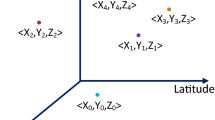Abstract
This paper reviews the development of methods for the analysis of hotspots and clustering. Discussion focusses on different data types and the usefulness of density estimation, scan testing and model-based approaches to clustering. Various application areas are considered ranging from ecology, over health mapping to genomics and landscape analysis. A discussion of software availability is also provided.
Similar content being viewed by others
References
Abellan J, Richardson S, Best N (2008) Use of space-time models to investigate the stability of patterns of disease. Environ Health Perspect. doi:10.1289/ehp.10814
Besag J, York J, Mollié A (1991) Bayesian image restoration with two applications in spatial statistics. Ann Ins Stat Math 43: 1–59
Bithell J (1990) An application of density estimation to geographical epidemiology. Stat Med 9: 691–701
Cowles MK (2004) Review of WinBUGS 1.4. Am Stat 58: 330–336
Denison D, Adams N, Holmes C, Hand D (2002) Bayesian partition modelling. Comput Stat Data Anal 38: 475–485
Denison D, Holmes C (2001) Bayesian partitioning for estimating disease risk. Biometrics 57: 143–149
Diggle PJ (2003) Statistical analysis of spatial point patterns, 2nd ed. Arnold, London
Eisen M, Spellman P, Brown P, Botstein D (1998) Cluster analsyis and display of genome-wide expression patterns. Proc Nat Acad Sci 95: 14863–14868
Environment Agency UK: (2003) Environmental genomics: an introduction. UK Government, London
Gangnon R, Clayton M (2000) Bayesian detection and modeling of spatial disease clustering. Biometrics 56: 922–935
Huang W, Umbach D, Ohler U, Li L (2006) Optimized mixed markov models for motif identification. BMC Bioinformat 7: 279. doi:10.1186/1471-2105-7-279
Kelsall J, Diggle P (1998) Spatial variation in risk of disease: a nonparametric binary regression approach. Appl Stat 47: 559–573
Kentros C, Hargreaves E, Hawkins R, Kandel E, Shapiro M, Muller R (1998) Abolition of long-term stability of new hippocampal place cell maps by nmda receptor blockade. Science 280: 2121–2126
Kentros CG, Agnihotri NT, Streater S, Hawkins RD, Kandel ER (2004) Increased attention to spatial context increases both place field stability and spatial memory. Neuron 42(2): 283–295
Knorr-Held L, Rasser G (2000) Bayesian detection of clusters and discontinuities in disease maps. Biometrics 56: 13–21
Kulldorff M, Athas W, Feuer E, Miller B, Key C (1998) Evaluating cluster alarms: a space-time scan statistic and brain cancer in Los Alamos. Am J Public Health 88: 1377–1380
Kulldorff M, Huang L, Pickle L, Duczmal L (2006) An elliptic spatial scan statistic. Stat Med 25: 3929–3943
Kulldorff M, Nagarwalla N (1995) Spatial disease clusters:detection and inference. Stat Med 14: 799–810
Kulldorff M, Tango T, Park PJ (2003) Power comparisons for disease clustering tests. Comput Stat Data Anal 42: 665–684
Lawson AB (1996) Markov chain Monte Carlo methods for spatial cluster processes. In: Computer science and statistics: proceedings of the interface, vol 27, pp. 314–319
Lawson AB (2000) Cluster modelling of disease incidence via rjmcmc methods: a comparative evaluation. Stat Med 19: 2361–2376
Lawson AB (2006) Statistical methods in spatial epidemiology, 2 ed. Wiley, New York
Lawson AB (2009) Bayesian disease mapping: hierarchical modeling in spatial epidemiology. CRC Press, New York
Lunn D, Spiegelhalter D, Thomas A, Best N (2009) The BUGS project: evolution, critique and future directions. Stat Med 28: 3049–3067
Molitor J, Marjoram P, Thomas D (2003) Fine-scale mapping of disease genes with multiple mutations via spatial clustering techniques. Am J Human Genetics 73: 1368–1384
Openshaw S, Charlton M, Wymer C, Craft A (1987) A mark I geographical analysis machine for the automated analysis of point data sets. Int J Geograph Inform Syst 1: 335–358
Patil G, Taillie C (2004) Upper level set scan statistic for detecting arbitrarily shaped hotspots. Environ Ecol Stat 11: 183–197
Patil GP, Bishop J, Meyers W, Taillie C, Vraney R, Wardrop D (2004) Detection and delineation of critical areas using echelons and spatial scan statistics with synoptic cellular data. Environ Ecol Stat 11: 139–164
Patil GP, Brooks R, Myers W, Rapport D, Taillie C (2001) Ecosystem health and its measurement. Ecosyst Health 7: 307–316
Patil GP, Modarres R, Meyers W, Patankar P (2006) Spatially constrained clustering and upper level set scan hotspot detection in surveillance geoinformatics. Environ Ecol Stat 13: 365–377
Richardson S, Thomson A, Best N, Elliott P (2004) Interpreting posterior relative risk estimates in disease mapping studies. Environ Health Perspect 112: 1016–1025
Scott DW (1992) Multivariate density estimation. Wiley, New York
Spiegelhalter D, Thomas A, Best N, Lunn D (2007) WinBUGS manual. MRC Biostatistics Unit, Cambridge,UK. version 1.4.3
Sun Y, Jacobsen D, Kardia S (2006) Chromoscan: a scan statistic application for identifying chromosomal regions in genomic studies. Bioinformatics 22: 2945–2947
Sun Y, Jacobsen D, Turner S, Boerwinkle E, Kardia S (2008) Fast implementation of a scan statistic for identifying chromosomal patterns of genome wide association studies. Comput Stat Data Anal. early view
Tango T, Takahashi K (2005) A flexibly shaped spatial scan statistic for detecting clusters. Int J Health Geograph 4: 11
Thalamuthu A, Mukhopadhyay I, Zheng X, Tseng G (2006) Evaluation and comparison of gene clustering methods in microarray analysis. Bioinformatics 22: 2405–2412
Viel J-F, Arveux P, Baverel J, Cahn J-Y (2000) Soft-tissue sarcoma and non-Hodgkin’s lymphoma clusters around a municipal solid waste incinerator with high dioxin emission levels. Am J Epidemiol 152: 13–19
Wang X, Tomso D, Chorley B, Cho H, Cheung V, Kleeberger S, Bell D (2007) Identification of polymorphic antioxidant response elements in the human genome. Human Mol Genetics 16: 1188–1200
Author information
Authors and Affiliations
Corresponding author
Rights and permissions
About this article
Cite this article
Lawson, A.B. Hotspot detection and clustering: ways and means. Environ Ecol Stat 17, 231–245 (2010). https://doi.org/10.1007/s10651-010-0142-z
Received:
Revised:
Published:
Issue Date:
DOI: https://doi.org/10.1007/s10651-010-0142-z




